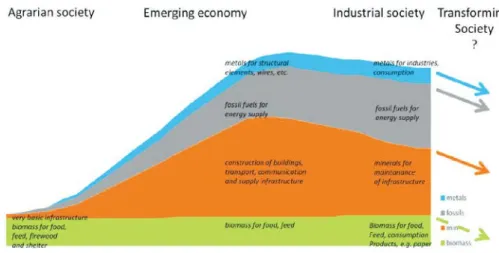Further Information: Bernd Franke, Institute for Energy and Environmental Research (ifeu), Wilckensstr. 3, 69120 Heidelberg, Germany, bernd.franke@ifeu.de; Tel. +49-(0)6221-476723 Research for sustainable development of urban growth centers in Africa and Asia funded by the German Ministry of Education and Research BMBF
Urban material and energy flows and their potential for synergetic use
Finding synergies with material flow analysis (MFA)
Sector specific resource management (such as for water, energy, mineral resources) is characterised by many interdependencies. For example: A biogas plant using bio waste as input can provide electricity for households and heat for nearby industry/ greenhouse. The output (sludge) from the biogas plant can be used e.g. in urban agriculture, thus reducing the water demand for agriculture.
However, this will only make sense when the synergies can be used feasibly with view on economic and ecological aspects. Hence material flow analysis is a tool to analyze the potentials for synergetic infrastructure management.
Country-wide material flow analysis
Methods for economy-wide material balances are well developed and standarized (Eurostat, OECD) Typically, the demand for minerals and metals is exceptionally high when countries construct large parts of their infrastructure. Industrialized countries that already possess massive and advanced infrastructure mostly have high levels of consumption of fossil fuels (depending on their main energy sources), but a medium level of consumption of minerals and metals, required for the maintenance of their built infrastructure.
Figure 1. Typical material consumption pattern during a development process
Figure 2. Per-capita material consumption in Rwanda, Vietnam and Egypt, 1990-2010 Population
and city area Kigali has the largest share of food production in the city limits of all four cities. Because of the relevance for the city’s material, energy and waste flows, the net commuter balance as well as type of crops and yields needs to be assessed.
Heating and cooling demand
The building energy demand in Frankfurt is characterized by heating demand whereas Danang and Assiut have a comparable potential cooling demand. The numbers for Kigali are small; if properly designed, no heating or coolong is necessary. Actual numbers for building energy consumption depends on building design and economic situation; cooling energy demand will surely increase if the energy is affordable. Thus, scenarios should reflect these conditions.
Per capita water and end energy consumption in case cities
Water: Danang’s fresh consumption rate is as high as in Frankfurt wheras Kigali’s total consumption (33 liters per person and day) is small. With little centralized waste water treatment in Kigali, almost 15 million m3 of waste water currently goes untreated and leads to significant surface water and ground water pollution.
Energy: The comparison of the balance of supply, consumption and treatment reveals specific differences and challenges for the cities.
Figure 3. Per capita water and energy consumption in the case cities Phosphate recovery: a link between the sectors waste water and food
The world’s food supplies are dependent on the phosphate (P2O5) fertilizer, a limited resource. It takes one ton of phosphate to produce 130 tons of grain, which is why the world mines about 170 million tons of phosphate rock every year to ship around the world and keep soils fertile. The potentially recoverable phosphate flow in waste materials derives from human excreta and compost from organic waste.
Findings:
A significant share of the phosphate consumption attributable to the population in the case cities can potentially be recovered in sewage sludge. By comparison, phosphate recovery in compost is of minor importance.
Biochar: a link between the sectors solid waste and energy
Charcoal thus represents 49% of Kigali’s total end energy consumption. Because the conversion efficiency from wood to charcoal is about 32%, about 910,000 tonnes of wood (almost 1 tonne per capita) are needed used annually for fuel wood and charcoal production. A high potential of largely untapped energy content in the city’s organic waste of 210,000 tonnes per year.
Findings:
Biochar production in Kigali can replace about 10% of Kigali’s demand for charcoal used for cooking in the city.
Selection of adequate technology and quality control of the product and processes is essential.
Experience gathered in small- scale plants by COPED are encouraging and should be analysed in more detail.
Authors: Bernd Franke, Mirjam Busch, Christin Zeitz (ifeu)
